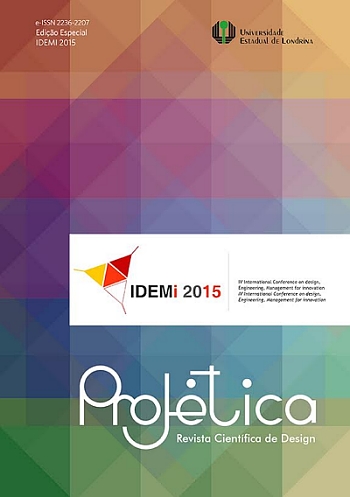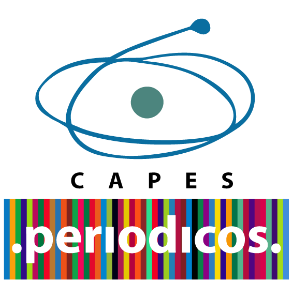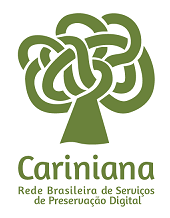Graphic Design and Speech Therapy: an interuniversity and transdisciplinary proposal aimed at inclusive graphic design solutions
DOI:
https://doi.org/10.5433/2236-2207.2015v6n2p09Keywords:
Design gráfico Inclusivo, Ergonomia Cognitiva, Distúrbios da comunicação e aprendizagem, DislexiaAbstract
This article aims to present the inter-university and transdisciplinarity partnership between Graphic Design and Speech Therapy to produce innovative research methodologies and project in inclusives materials that take into account the communication disorders, particularly visual. It is notorious the increasing discussion of the design function as a facilitator of information and its importance to the development of projects that are accessible to an ever larger and more diverse. In this sense, the Research Group on Inclusive Design Graphic: Vision, Hearing and Language has been conducting a broad dialogue with the Health Sciences, specifically Speech on inclusion in related areas such as the Graphic Design Design Informational, Instructional Design and Cognitive Ergonomics and its possible contributions in the disturbances in the area of language, such as low visual acuity, hearing and dyslexia. The research environments polarized between the Universidade Estadual Paulista (Unesp) - and the Univresidade de São Paulo (USP), where centers, laboratories and research groups are organized around common proposals. In addition to the theoretical foundation, they are being developed a set of specific actions including research around the appropriate printers to reading dyslexic, development of instructional materials printed for the deaf and digital instructional material for professionals working in the intervention of communication disorders. Such actions involve different forms of research - undergraduate, masters, doctorate and teaching - as well as the effective development of graphic design products aimed at inclusion.Downloads
References
BASTOS, Bárbara G. FERRARI, Deborah V. Internet e educação ao paciente. Arquivos Internacionais de Otorrinolaringologia, v. 15, n. 4, p. 515-522, 2011.
BONSIEPE, Gui. Design: do material ao digital. Florianópolis: FIESC/IEL, 1997.
CIASCA, S. M. Distúrbios e dificuldades de aprendizagem: questão de nomenclatura. In: CIASCA, S. M. Distúrbios de aprendizagem: proposta de avaliação interdisciplinar. São Paulo: Casa do Psicólogo; 2003.
CRISTOFOLINI, C.; MAGNI, C. Audição: relatos e experiências de professores do ensino fundamental. Revista Fonoaudiologia Brasil, Brasília, v. 2, p. 31-38, 2002.
DOMICIANO, C.L.C. et al. Ensaios em Design: arte, ciência e tecnologia. Bauru: Editora Canal 6, 2010.
DSM-IV-TRTM - "Manual diagnóstico e estatístico de transtornos mentais". Tradução Cláudia Dornelles. 4.ed. Porto Alegre: Artmed,2002.
FILATRO, A. "Design Instrucional na Prática". São Paulo: Pearson, 2008
FILATRO, A."Design Instrucional Contextualizado". São Paulo: Editora Senac, 2004
FREISCHMIDT, C.C.; KAY, M. R. Q. A voz do dono e o dono da voz? Considerações sobre a saúde vocal do professor". Revista Cadernos, v. 11, n. 3, p. 91-6, 2005.
GRUSZYNSKY, A. C. Design Gráfico: do invisível ao ilegível. Rio de Janeiro: Editora 2AB, 2000
GUIMARÃES, L. A Cor como Informação. 2.ed. São Paulo: Annablume, 2000.160p.
INSTITUTO BRASILEIRO DE GEOGRAFIA E ESTATÍSTICA, 2010. Disponível em: http://www.ibge.gov.br/home/estatistica/populacao/condicaodevida/indicadoresminimos/suppme/default_educacao.shtm. Acesso em: 10 de maio de 2014.
IÓRIO, C. "Avaliação dos encaminhamentos realizados por professores do ciclo básico para o serviço de Fonoaudiologia da Unidade Básica de Saúde de Vila Palmeiras - SP". 1999. Dissertação (Mestrado em Saúde Pública) - Faculdade de Saúde Pública, Universidade de São Paulo, São Paulo,1999.
JAINTA, S.; KAPOULA, Z. Dyslexic Children Are Confronted with Unstable Binocular Fixation while Reading. PLoS ONE, v. 6, n. 4: e18694. 2011. doi:10.1371/journal.pone.0018694
KOWLER, E. Eye movements: the past 25 years. Vision Research, v. 51, p. 1457-1483, 2011.
LACATOS, E.; MARCONI, M. Metodologia Científica. São Paulo: Ed. Atlas, 2009
LAND, M. F.; LEE, D. N. Where we look when we steer. Nature, v. 369, p. 742-744, 1994
LAND, M. F.; MCLEOD, P. From eye movements to action: How batsmen hit the ball. Nature Neuroscience, v. 3, n. 12, p. 1340-1345.
LI, X. JING, J.; YANG, D.; WANG, H.; WANG, Q.; SONG, S.; FAN, F. Eye-movement study during visual search in Chinese children with developmental dyslexia. Chinese Medical Journal, v. 22, n. 126, p. 4306- 11,2013.
MACHADO, A. M. A. "Introdução Ao Conceito De Design Inclusivo. Aplicações Práticas em Desenho Urbano e Equipamentos Sociais/Saúde". Lisboa: Serviço De Segurança Social Do Governo Português, 2006
MOUSINHO, R. A. Conhecendo a dislexia. Revista Sinpro, Rio de Janeiro, p. 26-33, 2003. (Ed. Especial.)
PRETTO, N. L. Formação de professores exige rede. Revista Brasileira de Educação, Rio de Janeiro, n. 20, Aug. 2002 . Available from . access on 16 Oct. 2013. http://dx.doi.org/10.1590/S1413- 24782002000200010
QUINTÃO, F.S.; TRISKA, R. Design de informação: origens, definições e fundamentos. Revista Infodesign, São Paulo, v. 11, n.1, 2014
RODRIGUES, S. T. O movimento dos olhos e a relação percepção-ação. In L. A. TEIXEIRA. Avanços em Comportamento Motor. Rio Claro, SP: Movimento, 2001. p.122-146.
Schneps, M.H. Thomson, J.M. Sonnert, G. Pomplun, M. "E-Readers Are More Effective than Paper for Some with Dyslexia". PLoS One, v. 8, n. 9, p. e 75634, 2013b.
SIMÃO, A.; HESKETH, C.G. Didática e Design Instrucional. Curitiba: IESDE, 2009
SPINILLO, C. G.; DA MAIA, A. F. D. V. M. O papel do design em projetos para daltônicos. In: CONFERÊNCIA INTERNACIONAL DE DESIGN, ENGENHARIA E GESTÃO PARA A INOVAÇÃO, 2., 2012, Florianópolis, SC. Anais... Florianópolis: [s.n], 2012
STENFELD, E.; MAISEL, J. "Universal Design: Creating Inclusive Environments". New Jersey, USA: John Wiley & Sons, 2012.
TIRESIAS. Disponível em: http://www.tiresias.org/announcement.htm. Acesso em: 12 de fev. 2015
TORREZZAN, C.; Behar, P. A. "Parâmetros para a construção de materiais educacionais digitais do ponto de vista do design pedagógico". In BEAHR, P.A.(org.) . Modelos Pedagógicos em Educação à Distância. Porto Alegre: Artmed, 2009
TULESKI, S. C.; EIDT, N. M. Repensando os distúrbios de aprendizagem a partir da psicologia histórico-cultural. Psicologia em Estudo, Maringá, v. 12, n. 3, p. 531-540, set./dez. 2007.
ZORZI, J. L. Fonoaudiologia e Educação: Encontros, desencontros e a busca de uma atuação conjunta. In. ZORZI, J. L. Aprendizagem e distúrbios da linguagem escrita. Porto Alegre: Artmed, 2003. cap. 9, p. 157-170.
Downloads
Published
How to Cite
Issue
Section
License
Copyright (c) 2015 Projetica

This work is licensed under a Creative Commons Attribution 4.0 International License.
Projética está licenciada sob a Creative Commons Attribution CC-BY 4.0 International. Os autores detém os direitos autorais e concedem à revista o direito de exclusividade de primeira publicação.
Os autores dos trabalhos aprovados autorizam Projética a, após a publicação, ceder seu conteúdo para reprodução em indexadores de conteúdo, bibliotecas virtuais e similares.
Os autores assumem que os textos submetidos à publicação são de sua criação original, responsabilizando-se inteiramente por seu conteúdo em caso de eventual impugnação por parte de terceiros. As opiniões emitidas pelos autores dos artigos são de sua exclusiva responsabilidade.
A revista se reserva o direito de efetuar, nos originais, alterações de ordem normativa, ortográfica e gramatical, com vistas a manter o padrão culto da língua e a credibilidade do veículo. Respeitará, no entanto, o estilo de escrever dos autores. Alterações, correções ou sugestões de ordem conceitual serão encaminhadas aos autores, quando necessário. Nesses casos, os artigos, depois de adequados, deverão ser submetidos a nova apreciação. As provas finais não serão encaminhadas aos autores.












